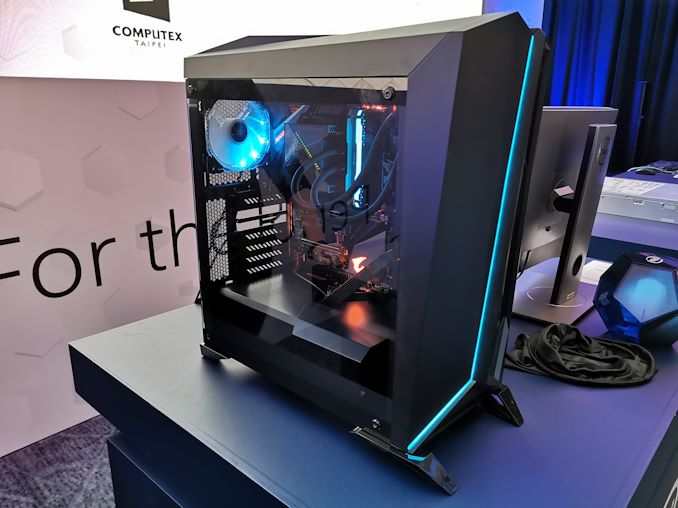Intel Announces 8 Core i9-9900KS: Every Core at 5.0 GHz, All The Time
by Ian Cutress on May 26, 2019 11:00 AM EST
Last year, Intel showcased a CPU during its keynote a processor with all of its cores at 5 GHz. Today, that becomes a reality – Intel is set to launch a processor that promises that frequency in any scenario. The new Core i9-9900KS is an 8-core processor that will run at 5.0 GHz during single core workloads and multi-core workloads.
That demo last year was on an overclockable 28-core Xeon CPU, but in reality was clocked way lower. There was even a good amount of controversy, as Intel didn’t state at the time they were using a sub-zero chiller to achieve that result. But this year we’re getting something a little more realistic. The new Core i9-9900KS uses the same silicon currently in the i9-9900K, but selectively binned in order to achieve 5.0 GHz on every core, all of the time.
Technically the CPU has a base frequency of 4.0 GHz, however it will only ever go down to that amount based on a default Intel BIOS (no consumer board uses the base BIOS specifications). The new CPU will be enabled in the same motherboards as the Core i9-9900K, but with a small firmware update. The CPU also has the same integrated graphics as the Core i9-9900K.
Intel did not tell us the TDP yet, but we will update this article when we know. Pricing and the launch date are also an unknown, however Intel SVP and GM Gregory Bryant is running a keynote here at Computex in a couple of days, and we expect to have the details then.
Update 05/28: As part of his Computex keynote, Gregory Bryant has confirmed that the processor is launching in Q4 of this year. Pricing and TDP will presumably be announced much closer to the actual launch.
| Intel 9th Gen Core 8-Core Desktop CPUs | ||||||||
| AnandTech | Cores | Base Freq |
All-Core Turbo | Single Core Turbo Freq |
IGP | DDR4 | TDP | Price (1ku) |
| i9-9900KS | 8 / 16 | 4.0 GHz | 5.0 GHz | 5.0 GHz | UHD 630 | 2666 | ? | ? |
| i9-9900K | 8 / 16 | 3.6 GHz | 4.7 GHz | 5.0 GHz | UHD 630 | 2666 | 95 W | $488 |
| i9-9900KF | 8 / 16 | 3.6 GHz | 4.7 GHz | 5.0 GHz | - | 2666 | 95 W | $488 |
| i7-9700K | 8 / 8 | 3.6 GHz | 4.6 GHz | 4.9 GHz | UHD 630 | 2666 | 95 W | $374 |
| i7-9700KF | 8 / 8 | 3.6 GHz | 4.6 GHz | 4.9 GHz | - | 2666 | 95 W | $374 |
The main difference compared to the Core i9-9900K is currently that all-core turbo value, which is a flat 5.0 GHz, a 300 MHz increase. There's a slight chance Intel might have increased the TDP, especially given that the base frequency (which TDP is built on) has increased 10% from 3.6 GHz to 4.0 GHz.
Why Intel Processors Draw More Power Than Expected: TDP and Turbo Explained
Intel did have a demo system for us to look at, which used a standard off-the-shelf motherboard and a closed loop liquid cooler. Intel confirmed that the chip is soldered, and that this is just simply the same silicon as the 9900K but better binned.
More info in a couple of days.
| Want to keep up to date with all of our Computex 2019 Coverage? | ||||||
 Laptops |
 Hardware |
 Chips |
||||
| Follow AnandTech's breaking news here! | ||||||











136 Comments
View All Comments
djayjp - Sunday, May 26, 2019 - link
Still not clear on the exact relationship between base and turbo. When will this chip run at base vs the latter?Ian Cutress - Sunday, May 26, 2019 - link
Base frequency is when the Tau moving window time has expired. How most modern high end motherboards set it to an effective unlimited time. Check the link to the TDP article.Opencg - Sunday, May 26, 2019 - link
At what voltage does it do 5ghz allcore. With what uncore. What about AVX. Is "all the time" really all the time.Zingam - Sunday, May 26, 2019 - link
Then comes a new exploit some ZombieSpectreMeltdown, which after fixes will let you run all but one core at 1GHz.Opencg - Monday, May 27, 2019 - link
And it will mean nothing outside of virtual machines just like every other side channel attack to date.mode_13h - Wednesday, May 29, 2019 - link
If side-channel attacks only affected VMs, then we'd only have to use mitigations when running on them. If you choose to disable mitigations on your box, then you should be careful where you point a web browser.MarcusMo - Sunday, May 26, 2019 - link
Great article, sadly I missed the link to it in my first read. The way you guys center links like that makes the eye think it's an ad or something. You should change that styling.imaheadcase - Sunday, May 26, 2019 - link
Base is simply the default that it would of ran if the BIOs defaulted to what chip was at. But since every motherboard will default to best performance it will now default to the "overclocked" performance because these chips binned for that. Much in the same way ram can operate, choose default for "safe" values, but the motherboard BIOS will pick fastest it can.magila - Sunday, May 26, 2019 - link
TLDR version: The base frequency is the the point at which the CPU's power draw equals its TDP when running a worst case workload (think Prime95 small FFT).The turbo frequency is the absolute maximum frequency CPU will run at with the given number of cores active if none of the power or thermal limits are hit first.
Full version: Intel CPUs maintain a moving average of their power consumption. By default the CPU will limit its frequency to keep this moving average at-or-below the TDP. If the CPU has been idle for a while its instantaneous power draw can exceed the TDP for a short time while the moving average catches up. The CPU's base frequency is the worst case frequency it will end up running at once the moving average and instantaneous power draw have converged to the TDP. Again, this is with a worst case workload such as Prime95 small FFT. For workloads which are not as power intensive the CPU's frequency can remain above the base frequency indefinitely, as long as the moving average power consumption remains at or below the TDP. In Intel's datasheets this moving average power limit is called PL1. PL1 is intended to represent the heat dissipation capacity of the CPU's cooler. Note that enthusiast motherboards almost always disable PL1, thus rendering everything I said above moot.
There is also a power limit called PL2 which is generally higher and uses an average over a much shorter time window. PL2 is meant to represent the power delivery capacity of the motherboard's VRM. Motherboards which disable PL1 often also disable PL2.
The turbo frequency table defines a set of maximum frequencies based on the number of active cores. These limits serve as a sort of backstop, only coming into play if none of the other power or thermal limits (there are several) are hit first. On motherboards which disable PL1 and PL2 the turbo frequencies will usually be what limits the CPU's operating frequency.
BigMamaInHouse - Sunday, May 26, 2019 - link
95W TDP right? :-).